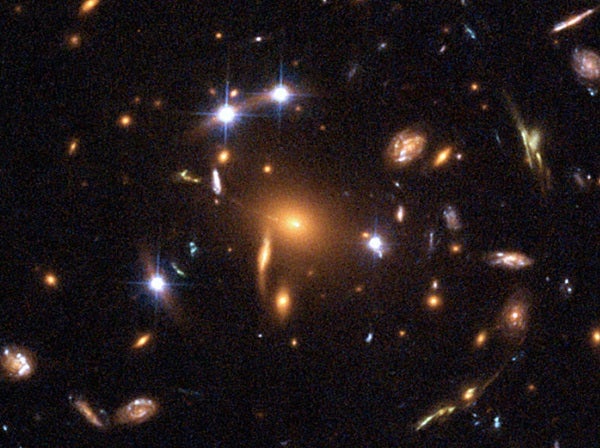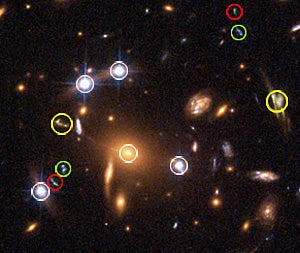Astronomers using the Hubble Space Telescope have captured the most-detailed view yet of a distant quasar “lensed” into five separate images. Multiple images of nearby galaxies appear as well.
The quintuple quasar, more prosaically named SDSS J1004+4112, was discovered by the Sloan Digital Sky Survey in 2003. The quasar is the brilliant, black-hole-powered core of a distant galaxy some 10 billion light-years away (or at a redshift of 1.74). Light traveling to Earth from this cosmic beacon runs into a cluster of galaxies about 7 billion light-years away (redshift 0.68).
“The special thing about SDSS J1004 is that it’s the first example of a
quasar that is multiply-imaged by a galaxy cluster,” says team member Graham Smith of the University of Birmingham in England.
As the quasar’s light passes through the galaxy cluster’s gravitational field, the light wends its way through warped space in such a way that it’s both magnified and split into five separate beams. Each beam creates a separate image of the object.
This process, called gravitational lensing, was predicted by Einstein. Astronomers first observed multiple images in the so-called Double Quasar (Q0957+561A,B) in 1979. In fact, until this find, the Double Quasar held the record for the largest separation between images (6″). The quintuple quasar’s images span an unprecedented 15″.
At first, astronomers counted only four quasars in SDSS J1004. But in follow-up work last year, a team led by the University of Tokyo’s Naohisa Inada identified a fifth image in the bright central galaxy.
“Arguably, the biggest scientific impact of SDSS J1004 may be in attempts to
measure the mysterious dark energy,” Smith says, because splitting angles in gravitational lenses are sensitive to different dark-energy values. But astronomers need precise constraints on the mass distribution of the lensing cluster to disentangle dark energy’s effects from other parameters in modeling the gravitational lens. “SDSS J1004 may be the outstanding lens that we have been looking for,” Smith adds. “The five quasar images provide very precise constraints due to their point-like nature.”
Whether this experiment is feasible, Smith says, the jury is still out, but one thing is certain. Before astronomers can make any definitive statements about dark energy, they’ll need to test and compare the results of many different, complementary techniques. “Further exploration of SDSS J1004 therefore has a very important role to play,” he notes.
In August, a team led by Keren Sharon and Eran Ofek of Tel Aviv University and including Smith identified several individual galaxies that were also warped into multiple images. The cluster distorts background galaxies into a funhouse array of shapes and sizes — sometimes stretching them into long arcs. And thanks to magnification by the cluster, astronomers can study some extremely distant galaxies. The farthest galaxy confirmed to date is 12 billion light-years away (redshift 3.33), based on spectra taken with Hawaii’s Keck Telescope. Astronomers are seeing this galaxy as it was only 1.8 billion years after the Big Bang.
SDSS J1004 lies in the constellation Leo Minor. Hubble imaged the object in April 2004 and in January and December 2005. By comparing images spanning a year, researchers discovered a supernova exploding in one of the cluster galaxies. This supernova exploded 7 billion years ago. Astronomers will use data from this and other supernova observations to reconstruct how these stellar blasts have enriched the universe with heavy elements.











